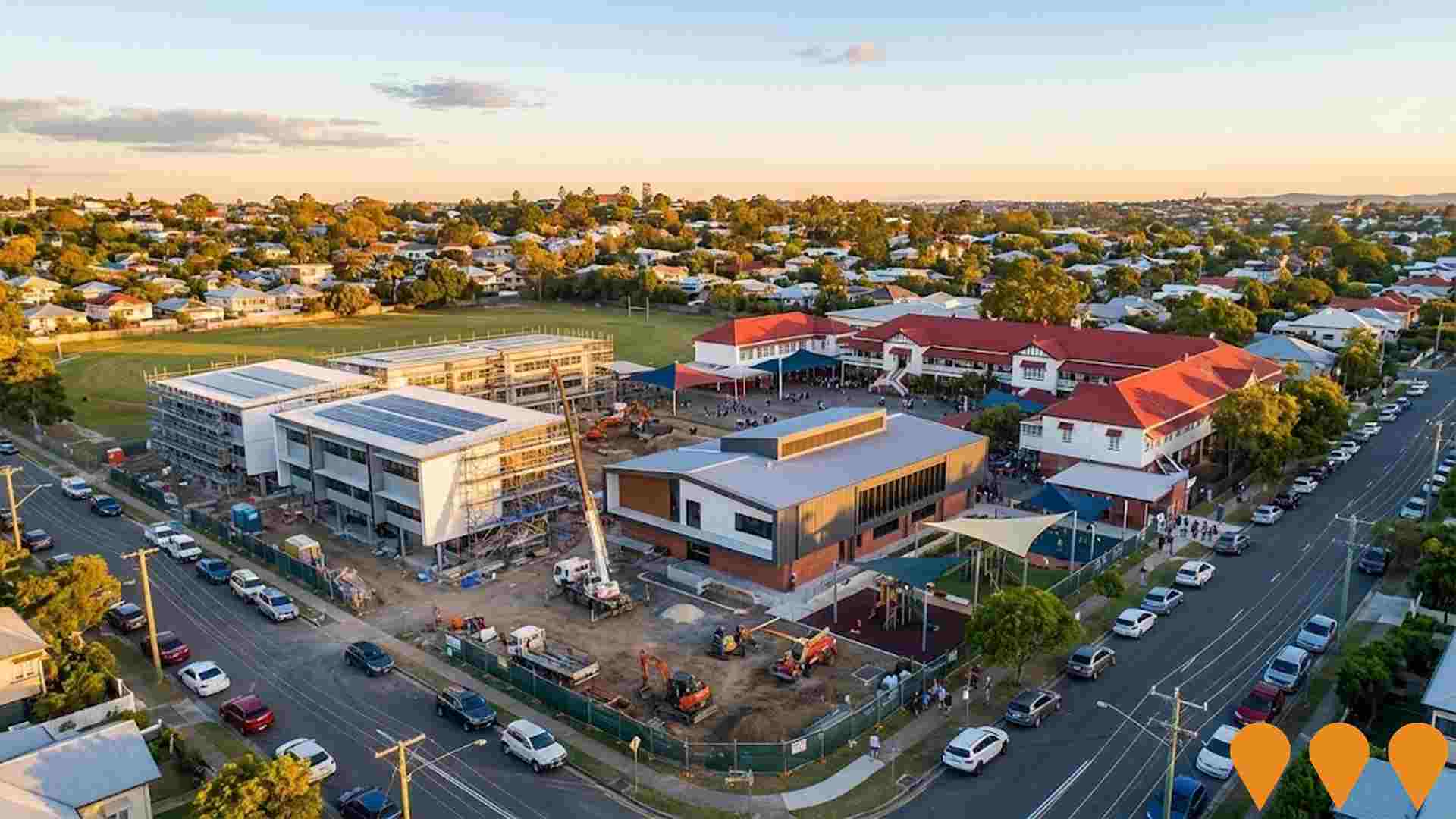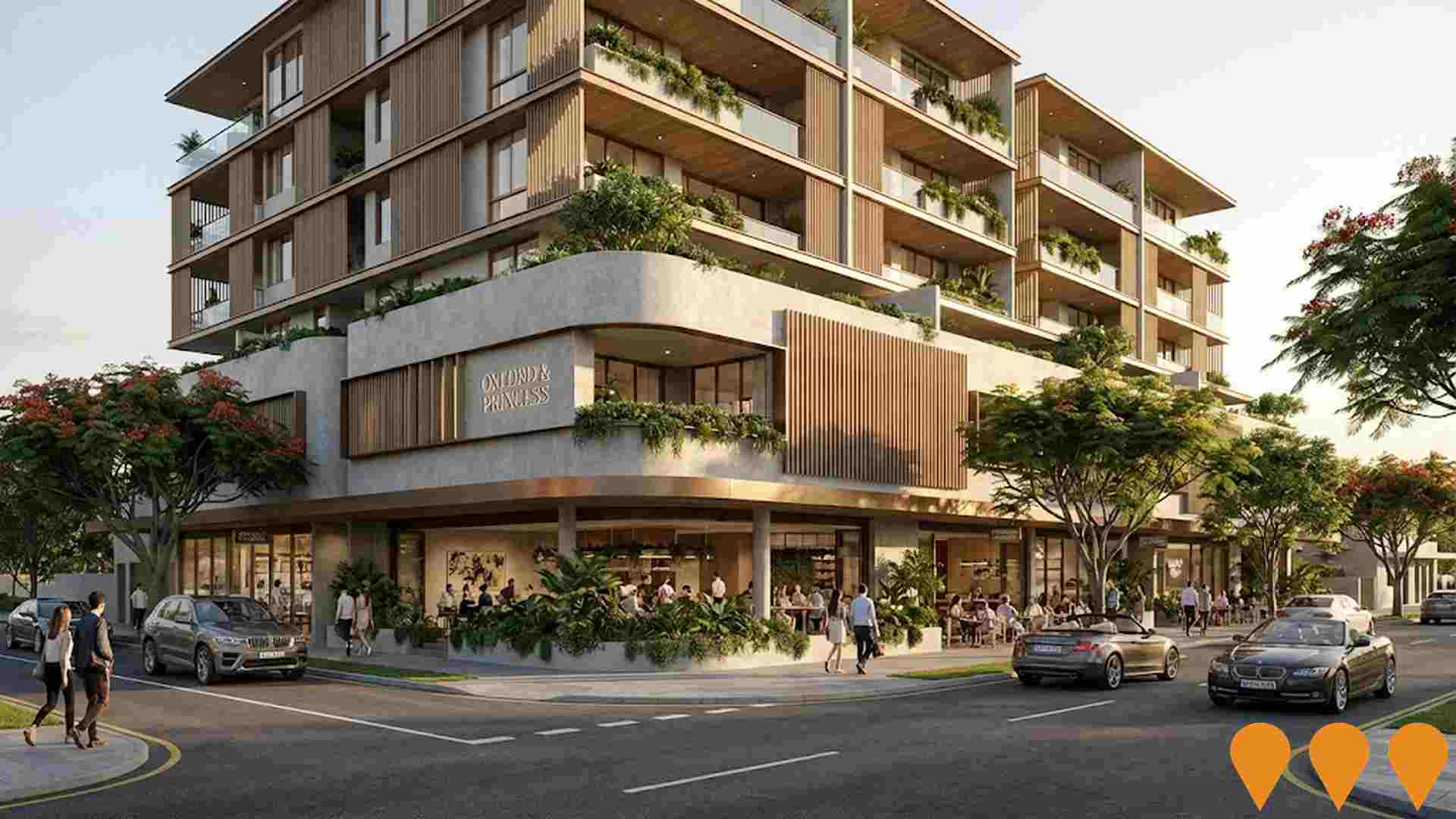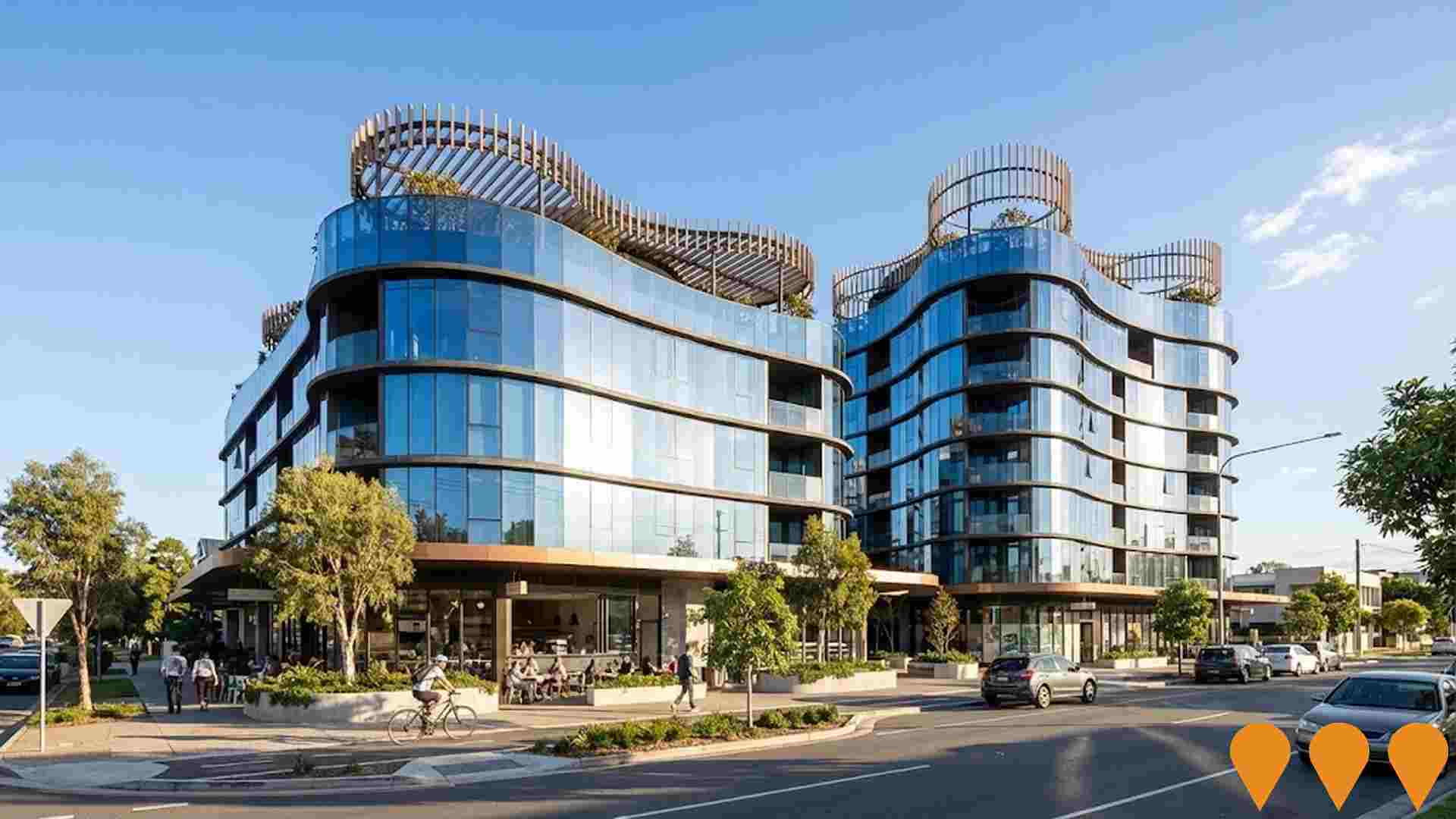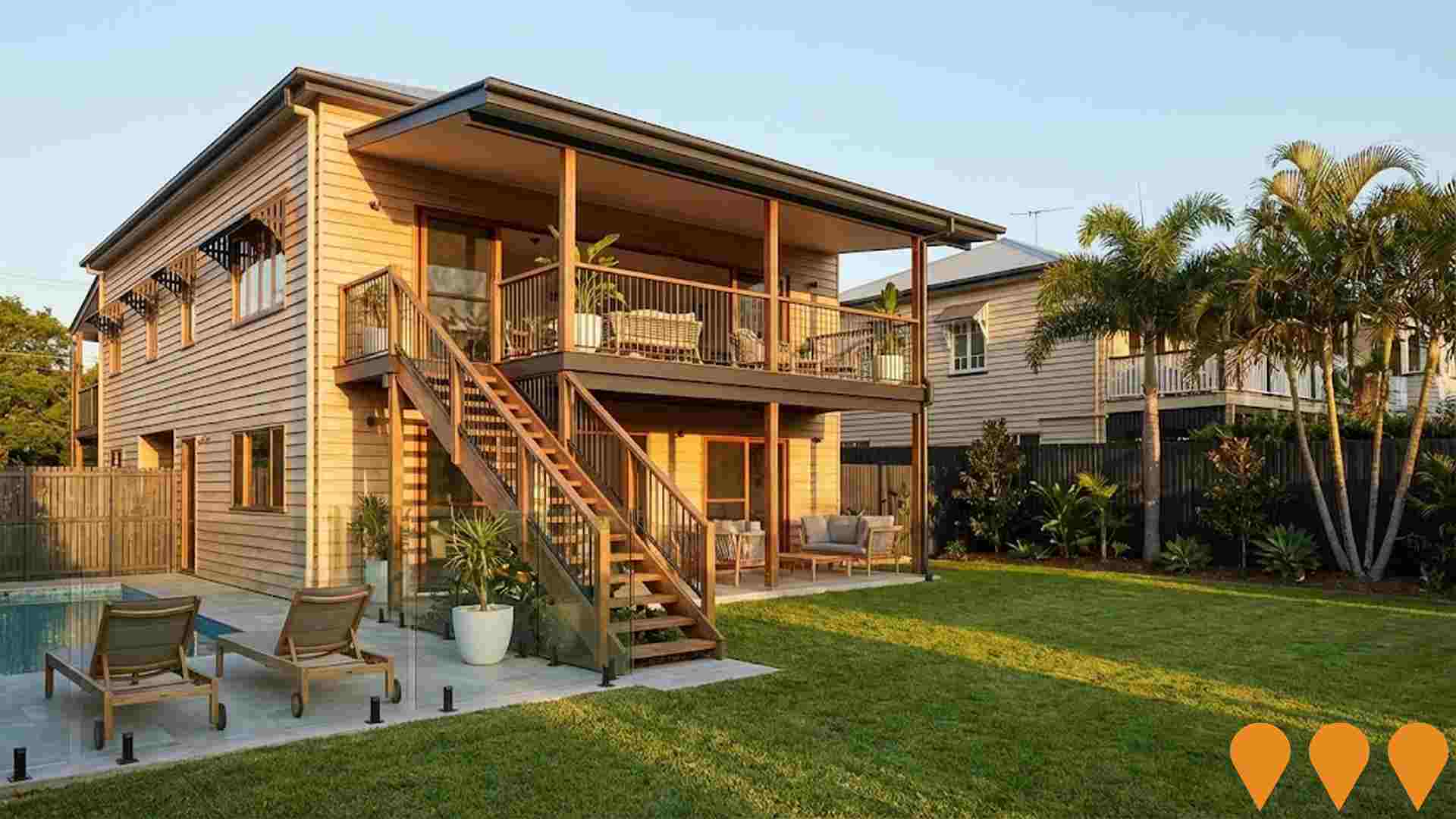Chart Color Schemes
est. as @ -- *
ABS ERP | -- people | --
2021 Census | -- people
Sales Activity
Curious about local property values? Filter the chart to assess the volume and appreciation (including resales) trends and regional comparisons, or scroll to the map below view this information at an individual property level.
Find a Recent Sale
Sales Detail
Population
Bulimba lies within the top quartile of areas nationally for population growth performance according to AreaSearch analysis of recent, and medium to long-term trends
Bulimba's population was around 7,911 as of November 2025, reflecting an increase of 504 people since the 2021 Census which reported a population of 7,407. This change is inferred from ABS estimated resident population data of 7,895 in June 2024 and 65 validated new addresses since the Census date. The population density ratio was 3,840 persons per square kilometer, placing Bulimba within the top 10% of national locations assessed by AreaSearch. Bulimba's 6.8% growth since the census is within 2.1 percentage points of the national average (8.9%). Overseas migration contributed approximately 84.6% of overall population gains during recent periods. AreaSearch adopts ABS/Geoscience Australia projections for each SA2 area, released in 2024 with a base year of 2022.
For areas not covered by this data and years post-2032, Queensland State Government's SA2 area projections are used, released in 2023 based on 2021 data. These state projections do not provide age category splits, so AreaSearch applies proportional growth weightings from ABS Greater Capital Region projections released in 2023 based on 2022 data for each age cohort. Future population trends project an above median growth for the area, with an expected increase of 1,347 persons to 2041, reflecting a total increase of 16.8% over the 17-year period.
Frequently Asked Questions - Population
Development
Residential development activity is slightly higher than average within Bulimba when compared nationally
Bulimba has received approximately 26 dwelling approvals per year over the past five financial years, totalling 131 homes. In the current financial year FY-26, 26 approvals have been recorded. On average, around 3.4 people moved to Bulimba annually for each dwelling built between FY-21 and FY-25, indicating a significant demand-supply imbalance that may lead to heightened competition among buyers. The average construction cost of new properties is $677,000, suggesting a focus on the premium segment by developers.
This financial year has seen $9.3 million in commercial development approvals, reflecting moderate levels of commercial growth. Compared to Greater Brisbane, Bulimba's rate of new dwelling approvals per person is approximately two-thirds lower, placing it among the 43rd percentile nationally when assessed for buyer choice. This suggests a relatively constrained market with potential interest in existing dwellings. New development primarily consists of detached houses (36.0%) and townhouses or apartments (64.0%), favouring compact living options that attract downsizers, investors, and first-time purchasers. Bulimba's population is expected to grow by 1,326 residents through to 2041.
If current development rates continue, housing supply may struggle to keep pace with population growth, potentially intensifying buyer competition and supporting price increases.
Frequently Asked Questions - Development
Infrastructure
Bulimba has strong levels of nearby infrastructure activity, ranking in the top 40% nationally
Changes to local infrastructure significantly impact an area's performance. AreaSearch has identified 35 projects likely to affect the region. Notable initiatives include Oxford & Princess - Bulimba Mixed-Use Development, QParks Group - 5 Riding Road Mixed-Use Development, Bulimba State School Infrastructure Upgrade, and Bulimba Memorial Park and Community Centre Upgrade. The following list details those most relevant.
Professional plan users can use the search below to filter and access additional projects.
INFRASTRUCTURE SEARCH
 Denotes AI-based impression for illustrative purposes only, not to be taken as definitive under any circumstances. Please follow links and conduct other investigations from the project's source for actual imagery. Developers and project owners wishing us to use original imagery please Contact Us and we will do so.
Denotes AI-based impression for illustrative purposes only, not to be taken as definitive under any circumstances. Please follow links and conduct other investigations from the project's source for actual imagery. Developers and project owners wishing us to use original imagery please Contact Us and we will do so.
Frequently Asked Questions - Infrastructure
Teneriffe Banks
Brisbane's largest private mixed-use riverfront development by Kokoda Property. Five towers delivering 213 luxury residential apartments, Brisbane's first Kimpton Hotel (163 keys), commercial office space, riverfront dining, retail and over 4,800 sqm of public waterfront amenities including a 220 m riverwalk extension. Staged construction is underway with first completions expected 2027.
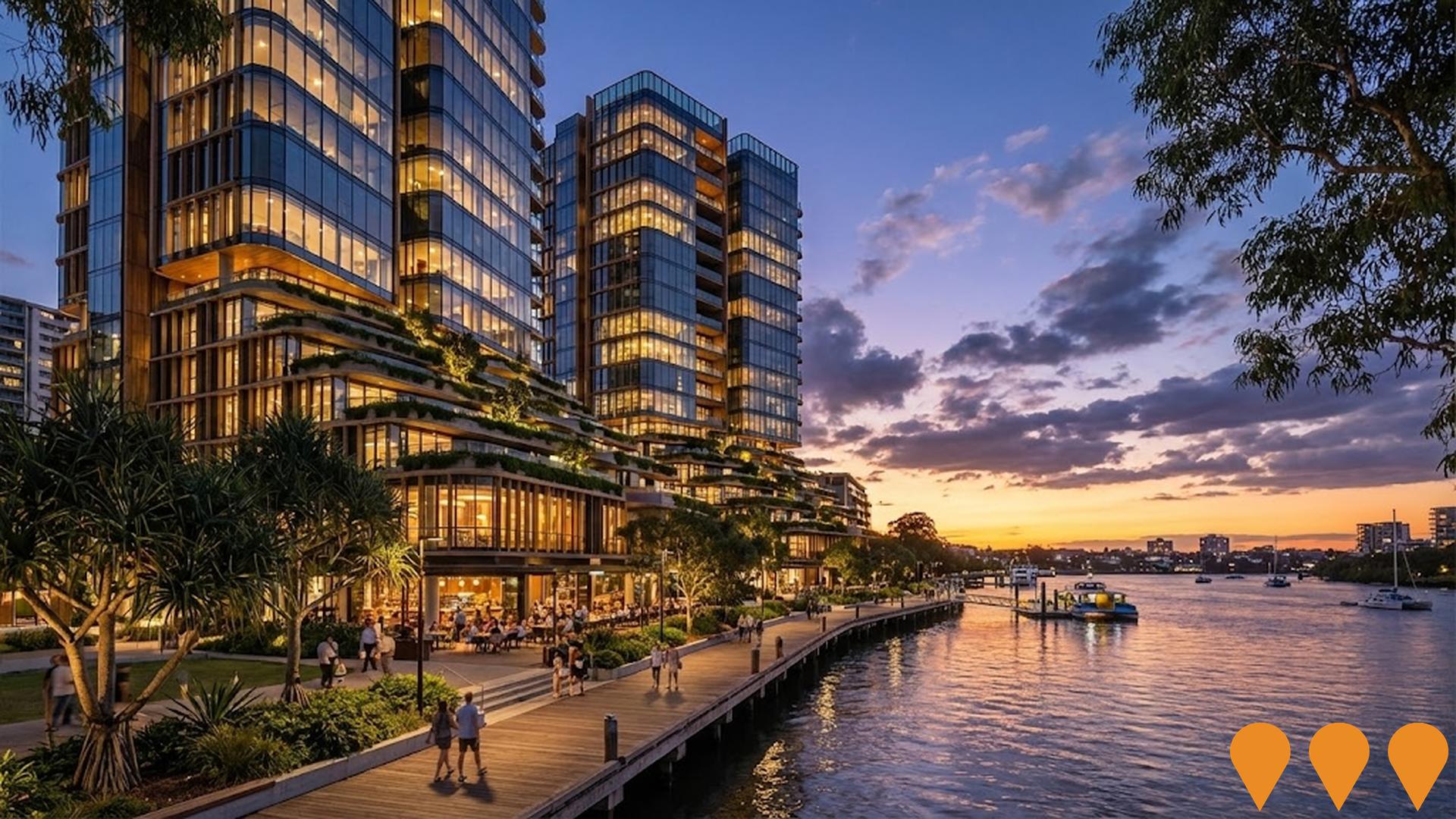
Lua Bulimba - Oxford Street Lifestyle Precinct
A completed three-level mixed-use lifestyle precinct on Oxford Street, Bulimba, anchored by a full-line Harris Farm Markets supermarket. Includes boutique food and beverage operators, wellness tenancies, specialty retail and a rooftop dining and entertainment venue. The project has revitalised the western end of the Oxford Street retail strip with upgraded streetscapes, laneway activation and new public realm improvements.

Waterfront Newstead - Mirvac Masterplan
Long-running, $1 billion masterplanned community and urban renewal project by Mirvac along the Brisbane River. The precinct includes luxury apartments, build-to-rent housing (LIV Anura), commercial and retail spaces, and over 50% dedicated public parkland and open space. The 'Sky Precinct' is the latest phase, with Quay (135 apartments) recently completed, Isle (133 apartments) under construction with expected completion in 2026, and the final residential tower (Sky Stage 3, 138 apartments) approved.

Bulimba Barracks Master Plan
Major redevelopment of the 20-hectare former Bulimba Barracks site into a masterplanned community. The project includes approximately 855 residential dwellings (apartments and townhouses), a retail and dining precinct centred around the heritage fabrication workshop, and extensive riverfront parklands. Remediation and civil works are currently progressing.
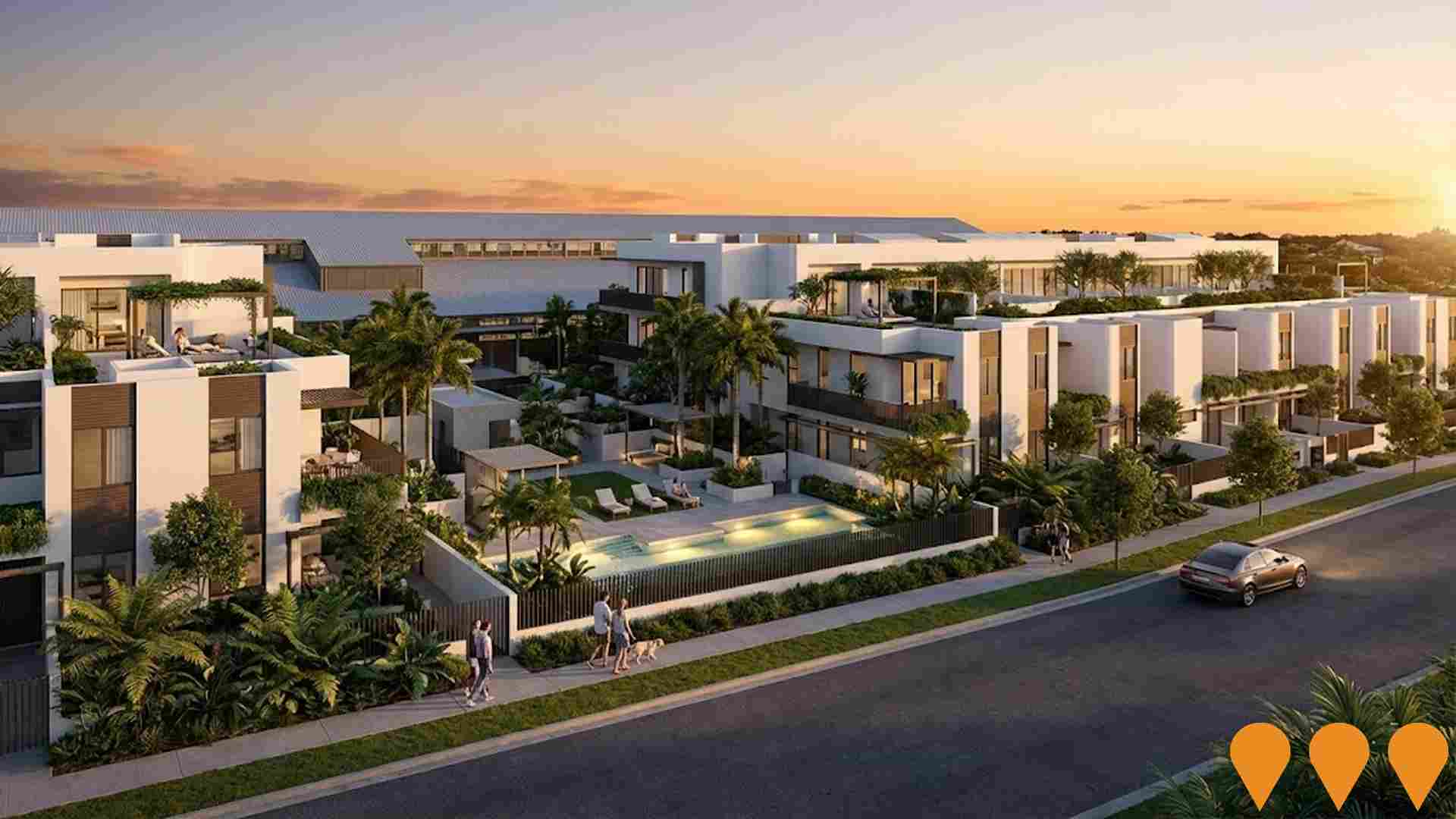
Isle Waterfront Newstead
25-level luxury apartment development by Mirvac featuring 133 apartments with resort-style amenities including infinity pool, wellness centre, and over 10,000 plants creating a green urban oasis. Part of the $1 billion Waterfront Newstead community.
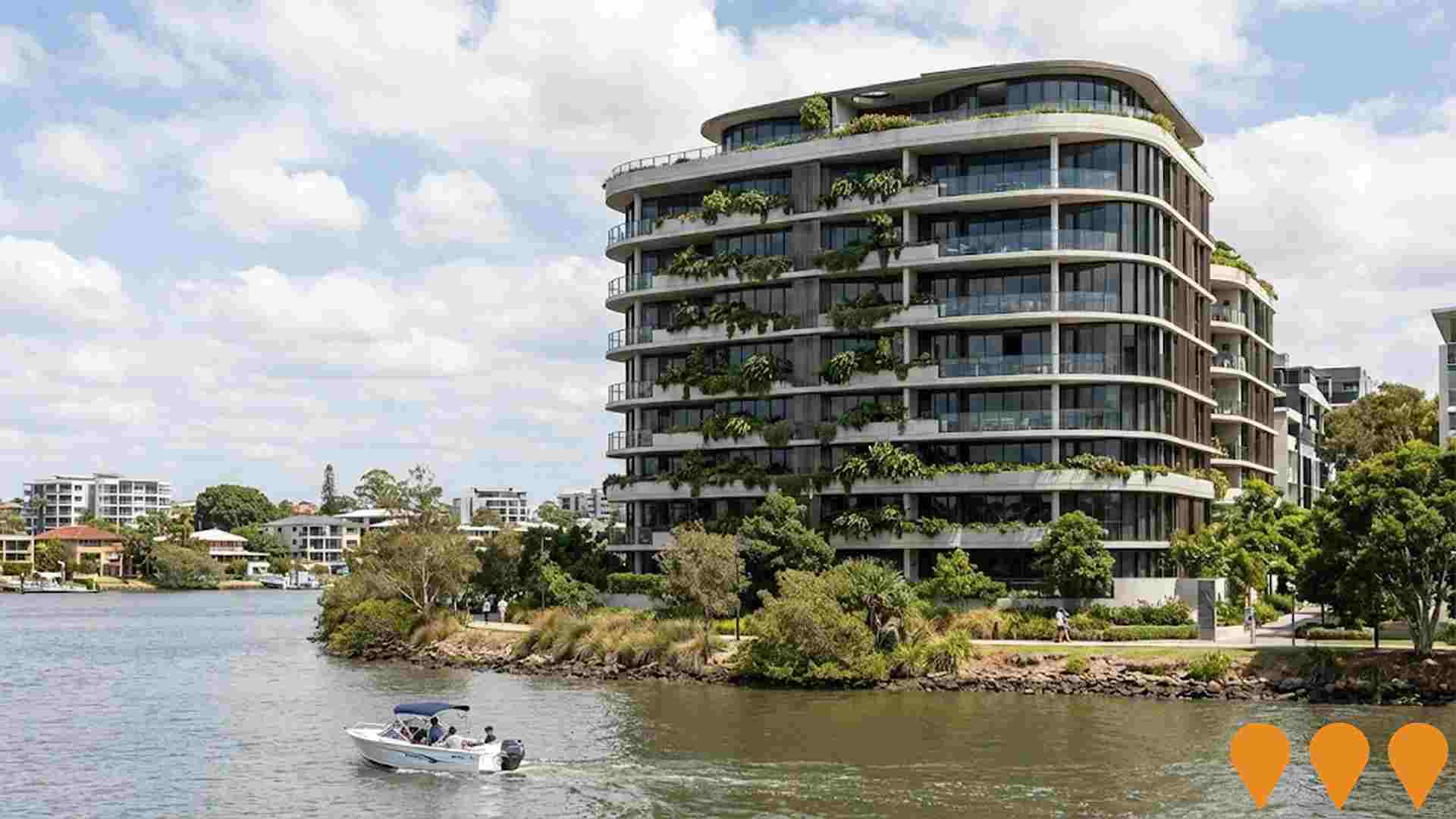
Bulimba Memorial Park and Community Centre Upgrade
Staged upgrade of the heritage listed Bulimba Memorial Park to provide a safer, more modern family playground and improved community recreation facilities. Stage 1 replaces ageing equipment and damaged trees with a new toddler and young children play area, shade and seating. Stage 2 is funded and will deliver new play equipment for older children, additional fencing along Stuart Street, better drainage and refreshed park landscaping. The project protects the park's memorial character while supporting local sport, community events and everyday use.
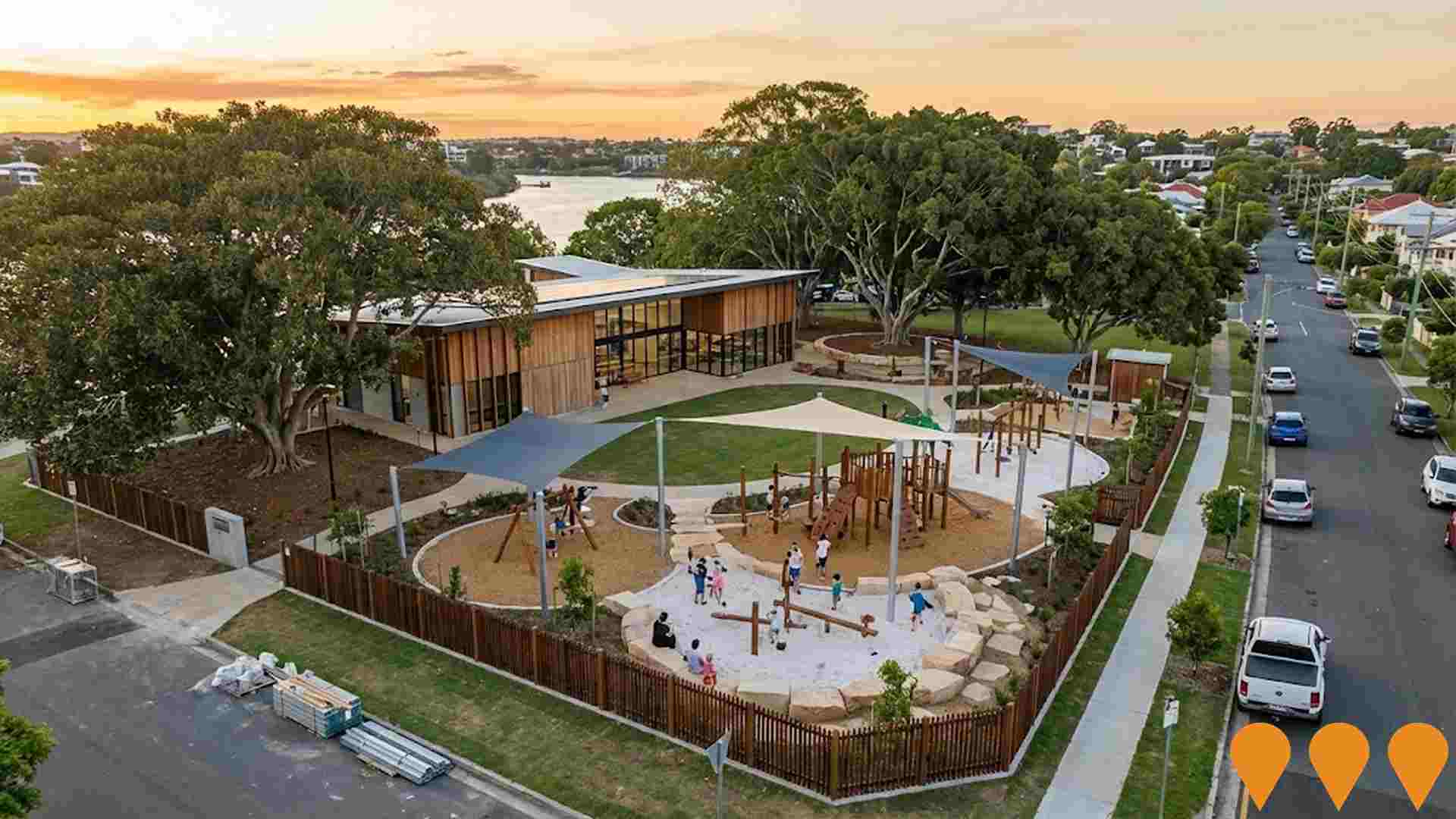
Riverside Green - Bulimba Creek Parkland Enhancement
Parkland enhancement along Bulimba Creek focused on trail upgrades, native vegetation restoration, play space renewal, and improved stormwater treatment to strengthen the local creek corridor and community access.
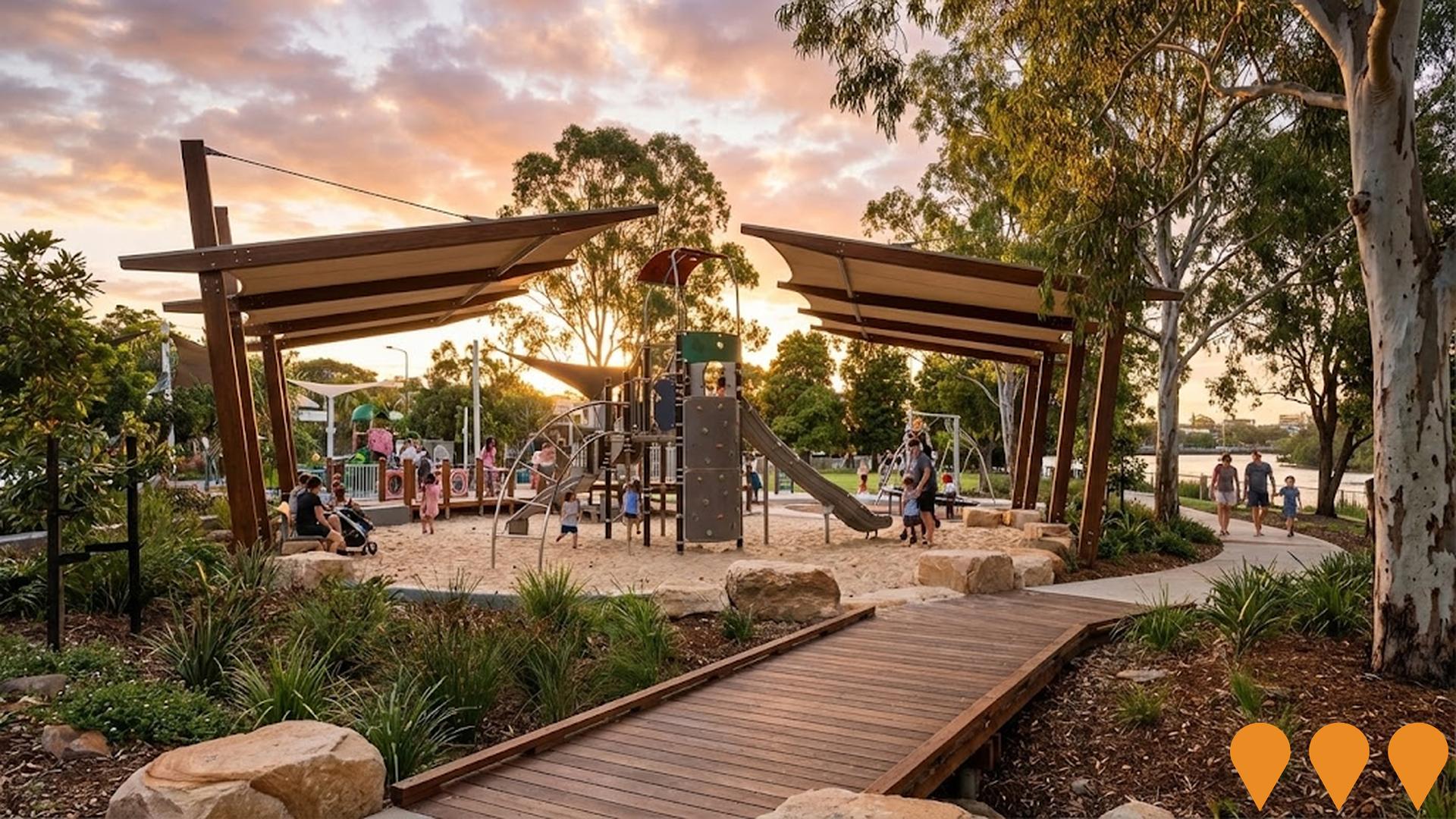
Community Health Hub - Bulimba
Proposed community health facility providing primary care services, allied health, community health programs, and specialist outreach services to serve the growing Bulimba population.
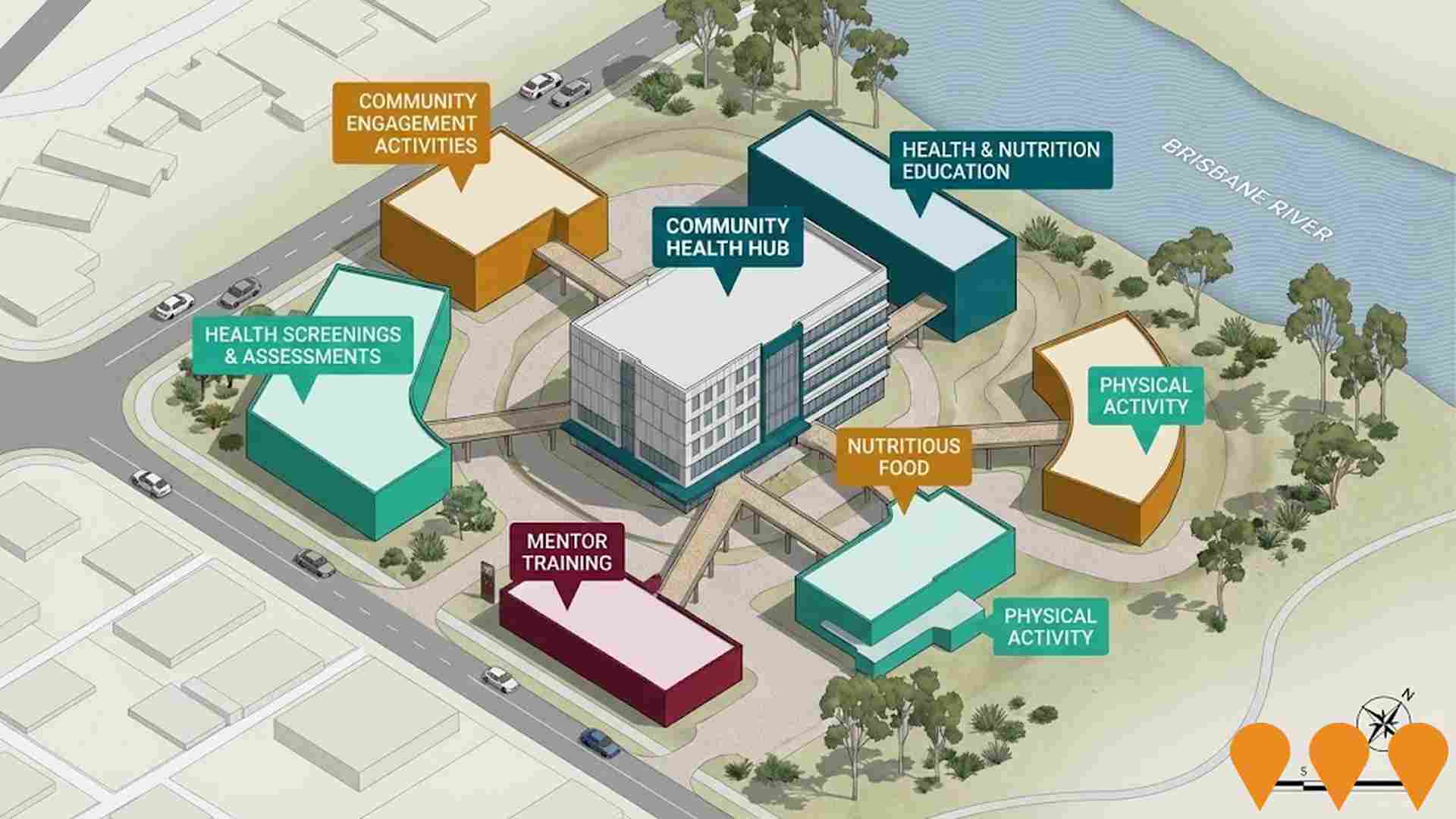
Employment
The exceptional employment performance in Bulimba places it among Australia's strongest labour markets
Bulimba has a highly educated workforce with professional services well represented. Its unemployment rate was 1.8% in June 2025, lower than Greater Brisbane's 4.1%.
Employment growth over the past year was estimated at 3.1%. As of June 2025, 5,098 residents were employed with a workforce participation rate of 71.2%, higher than Greater Brisbane's 64.5%. Key employment sectors are professional & technical, health care & social assistance, and education & training. Bulimba specialises in professional & technical jobs, at 1.8 times the regional level, but has lower representation in health care & social assistance (13.1% vs regional average of 16.1%).
Employment opportunities locally may be limited as indicated by Census data. Between June 2024 and June 2025, employment levels increased by 3.1%, labour force grew by 2.9%, reducing the unemployment rate by 0.2 percentage points. In contrast, Greater Brisbane had employment growth of 4.4% and a 0.4 percentage point drop in unemployment. Jobs and Skills Australia's national employment forecasts from May 2025 project overall growth of 6.6% over five years and 13.7% over ten years. Applying these projections to Bulimba's employment mix suggests local growth of approximately 7.1% over five years and 14.3% over ten years, though these are simple extrapolations for illustrative purposes only.
Frequently Asked Questions - Employment
Income
The economic profile demonstrates exceptional strength, placing the area among the top 10% nationally based on comprehensive AreaSearch income analysis
Bulimba's median income among taxpayers was $76,477 in financial year 2022. The average income stood at $132,680 during the same period. These figures compare to Greater Brisbane's median and average incomes of $55,645 and $70,520 respectively. By September 2025, estimates suggest Bulimba's median income will be approximately $87,176, and the average will be around $151,242, based on a 13.99% growth in wages since financial year 2022. Census data shows that household, family, and personal incomes in Bulimba rank between the 96th and 97th percentiles nationally. Income distribution reveals that 36.2% of Bulimba's population (2,863 individuals) fall within the $4000+ income range, differing from regional patterns where the dominant range is $1,500 - 2,999 with 33.3%. The significant proportion of high earners (48.5% above $3,000/week) indicates strong economic capacity throughout Bulimba. Housing accounts for 14.3% of income in the area, and residents rank within the 96th percentile for disposable income. Bulimba's SEIFA income ranking places it in the 10th decile.
Frequently Asked Questions - Income
Housing
Bulimba displays a diverse mix of dwelling types, with above-average rates of outright home ownership
The dwelling structure in Bulimba, as per the latest Census, consisted of 46.2% houses and 53.8% other dwellings (semi-detached, apartments, 'other' dwellings). In comparison, Brisbane metropolitan area had 52.7% houses and 47.3% other dwellings. Home ownership in Bulimba stood at 28.1%, with the rest being mortgaged (35.1%) or rented (36.9%). The median monthly mortgage repayment was $2,800, higher than Brisbane metro's average of $2,500. The median weekly rent in Bulimba was $500, compared to Brisbane metro's $440. Nationally, Bulimba's mortgage repayments were significantly higher at $2,800 versus the Australian average of $1,863, and rents were substantially above the national figure of $375.
Frequently Asked Questions - Housing
Household Composition
Bulimba has a typical household mix, with a fairly typical median household size
Family households account for 71.4% of all households, including 31.7% couples with children, 30.2% couples without children, and 8.4% single parent families. Non-family households constitute the remaining 28.6%, with lone person households making up 25.4% and group households comprising 3.3%. The median household size is 2.4 people, which aligns with the Greater Brisbane average.
Frequently Asked Questions - Households
Local Schools & Education
The educational profile of Bulimba exceeds national averages, with above-average qualification levels and academic performance metrics
Bulimba's educational attainment is notably high, with 50.8% of residents aged 15+ holding university qualifications, compared to 25.7% in Queensland (QLD) and 30.4% nationwide. Bachelor degrees are the most common at 33.2%, followed by postgraduate qualifications (12.6%) and graduate diplomas (5.0%). Vocational pathways account for 23.3% of qualifications, with advanced diplomas at 10.1% and certificates at 13.2%. Educational participation is high, with 29.1% of residents currently enrolled in formal education.
This includes 9.5% in primary education, 7.7% in secondary education, and 7.1% pursuing tertiary education. Educational facilities appear to be located outside Bulimba's immediate boundaries, requiring families to access schools in neighboring areas.
Frequently Asked Questions - Education
Schools Detail
Nearby Services & Amenities
Transport
Transport servicing is high compared to other areas nationally based on assessment of service frequency, route connectivity and accessibility
Bulimba has 37 active public transport stops, including both ferry and bus services. These stops are served by 9 different routes that together facilitate 2,700 weekly passenger trips. The average distance from residents to the nearest stop is 154 meters, indicating excellent transport accessibility.
Across all routes, service frequency averages 385 trips per day, which translates to approximately 72 weekly trips per individual stop.
Frequently Asked Questions - Transport
Transport Stops Detail
Health
Bulimba's residents boast exceedingly positive health performance metrics with very low prevalence of common health conditions across all age groups
Bulimba has excellent health outcomes across all age groups, with a very low prevalence of common health conditions. The private health cover rate is exceptionally high at approximately 82%, with 6,510 people covered, compared to Greater Brisbane's 73.8% and the national average of 55.3%. Mental health issues and asthma are the most prevalent medical conditions in Bulimba, affecting 7.6% and 6.6% of residents respectively.
A total of 74.8% of residents report no medical ailments, compared to 74.9% across Greater Brisbane. The area has a higher proportion of seniors aged 65 and over, with 16.8%, or 1,325 people, compared to Greater Brisbane's 11.3%. Despite this, health outcomes among seniors in Bulimba are strong and align with the general population's health profile.
Frequently Asked Questions - Health
Cultural Diversity
The level of cultural diversity witnessed in Bulimba was found to be above average when compared nationally for a number of language and cultural background related metrics
Bulimba's cultural diversity is above average, with 12.0% speaking a language other than English at home and 27.6% born overseas. Christianity is the predominant religion in Bulimba at 50.7%, compared to 47.7% across Greater Brisbane. The top three ancestry groups are English (29.8%), Australian (22.1%), and Irish (10.5%).
Notably, Scottish representation is higher than regional averages at 9.7%. French and Welsh representations are similar regionally at 0.8% each.
Frequently Asked Questions - Diversity
Age
Bulimba's population is slightly older than the national pattern
Bulimba has a median age of 41, which is higher than Greater Brisbane's figure of 36 and Australia's figure of 38. The 55-64 age cohort is notably over-represented in Bulimba at 14.9%, compared to the Greater Brisbane average, while the 25-34 age group is under-represented at 12.2%. From 2021 to present, the 75-84 age group has grown from 4.0% to 5.9% of the population, and the 55-64 cohort increased from 13.1% to 14.9%. Conversely, the 35-44 age group has declined from 16.1% to 14.5%, and the 45-54 age group dropped from 15.9% to 14.3%. By 2041, Bulimba's age profile is projected to evolve significantly. The 75-84 age cohort is expected to grow by 412 people (89%), increasing from 465 to 878. Notably, the combined 65+ age groups will account for 64% of total population growth, reflecting the area's aging demographic profile. Meanwhile, the 5-14 and 0-4 age cohorts are expected to experience population declines.

